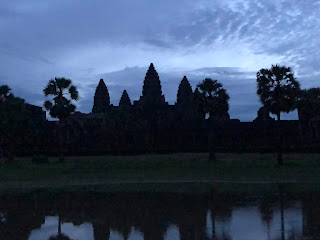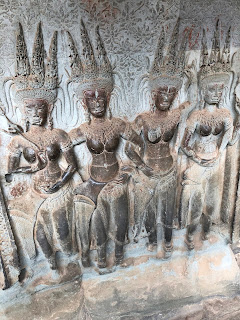Last year, it was about a sunrise. This year, sunsets.
I'm trying not to read too much into that. I am being quite literal: Last year, one important reason I went to Cambodia was to see the sun rise over the Angkor Wat. This year, I wanted to see the sun set at least once in one of the Cyclaides Islands, though it didn't loom quite as large among my reasons for coming to Greece.
But a sunset I wanted, and a sunset I got.
Yesterday, I got to Santorini later than I expected and my hotel was further from Oia, that village you see all over Instagram, than I thought.
Then again, the Hotel Santa Irina is right by what some believe to be the nicest beach on the island. Better yet (or worse, if I am going to wear the bathing suit I brought), there's a great bakery, also called the Santa Irina, on the premises.
The hotel's receptionist--Georgia, a sweet woman about my age--suggested another nearby village for a sunset. "The one in Pirgos is unique," she said. A few local people echoed her belief.
I must say, it certainly is unlike any other I've seen. And yes, it's beautiful.
All right, I'm going to "come out" about something else. (Believe it or not, even after you've revealed yourself as transgender and begun to live as who you are, there are still all sorts of other ways in which you can "come out.") It's something you may have already figured: I am a romantic. There, I've said it.
I'm trying not to read too much into that. I am being quite literal: Last year, one important reason I went to Cambodia was to see the sun rise over the Angkor Wat. This year, I wanted to see the sun set at least once in one of the Cyclaides Islands, though it didn't loom quite as large among my reasons for coming to Greece.
But a sunset I wanted, and a sunset I got.
Yesterday, I got to Santorini later than I expected and my hotel was further from Oia, that village you see all over Instagram, than I thought.
Then again, the Hotel Santa Irina is right by what some believe to be the nicest beach on the island. Better yet (or worse, if I am going to wear the bathing suit I brought), there's a great bakery, also called the Santa Irina, on the premises.
The hotel's receptionist--Georgia, a sweet woman about my age--suggested another nearby village for a sunset. "The one in Pirgos is unique," she said. A few local people echoed her belief.
I must say, it certainly is unlike any other I've seen. And yes, it's beautiful.
All right, I'm going to "come out" about something else. (Believe it or not, even after you've revealed yourself as transgender and begun to live as who you are, there are still all sorts of other ways in which you can "come out.") It's something you may have already figured: I am a romantic. There, I've said it.















































